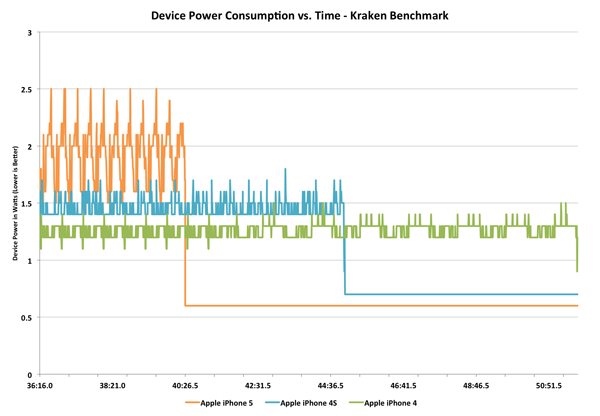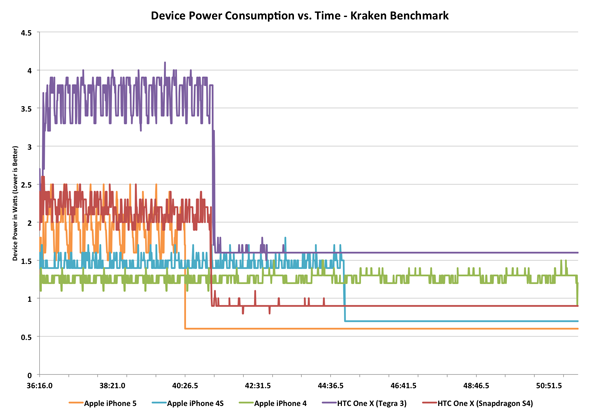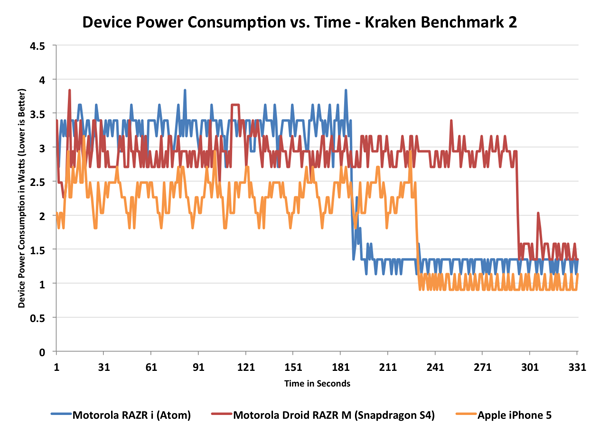The iPhone 5 Review
by Anand Lal Shimpi, Brian Klug & Vivek Gowri on October 16, 2012 11:33 AM EST- Posted in
- Smartphones
- Apple
- Mobile
- iPhone 5
Increased Dynamic Range: Understanding the Power Profile of Modern SoCs
Section by Anand Shimpi
The iPhone 4S greatly complicated the matter of smartphone power consumption. With the A5 SoC Apple introduced a much wider dynamic range of power consumption to the iPhone than we were previously used to. Depending on the workload, the A5 SoC could either use much more power than its predecessor or enjoy decreased overall energy usage. I began our battery life analysis last time with some graphs showing the power savings realized by a more power hungry, faster CPU.
The iPhone 5 doesn't simplify things any more. I believe the days of us having straightforward discussions about better/worse battery life are long gone. We are now firmly in the era of expanded dynamic range when it comes to smartphone power consumption. What do I mean by that? The best way to explain is to look at some data. The graphs below show total device power consumption over time for a handful of devices running the Mozilla Kraken javascript benchmark. Kraken is multithreaded and hits the CPU cores fairly well. The power profile of the benchmark ends up being very similar to loading a very js-heavy web page, although for a longer period of time. All of the device displays were calibrated to 200 nits, although obviously larger displays can consume more power.
Let's start out by just looking at the three most recent iPhone generations:
The timescale for this chart is just how long the iPhone 4 takes to complete the Kraken benchmark. The iPhone 4/4S performance gap feels a lot bigger now going back to the 4 than it did when the 4S launched, but that's how it usually seems to work. Note how tight the swings are between min and max power consumption on the iPhone 4 during the test. As a standalone device you might view the iPhone 4 as being fairly variable when it comes to power consumption but compared to the 4S and 5 it might as well be a straight line.
The 4S complicated things by consuming tangibly more power under load than the 4, but being fast enough to complete tasks in appreciably less time. In the case of this Kraken run, the 4S consumes more power than the 4, however it's able to go to sleep quicker than the 4 and thus draw less power. If we extended the timeline for the iPhone 4 significantly beyond the end of its benchmark run we'd see the 4S eventually come out ahead in battery life as it was able to race to sleep quicker. The reality is that with more performance comes increased device usage - in other words, it's highly unlikely that with a 50% gain in performance users are simply going to continue to use their smartphone the same way as they would a slower device. Usage (and thus workload) doesn't remain constant, it's somewhat related to response time.
The iPhone 5 brings new meaning to device level power consumption. With a larger display and much more powerful CPU, it can easily draw 33% more power than the 4S under load, on average. Note the big swings in power consumption during the test. The A6 SoC appears to be more aggressive in transitioning down to idle states than any previous Apple SoC, which makes sense given how much higher its peak power consumption can be. Looking at total energy consumed however, the iPhone 5 clearly has the ability to be more power efficient on battery. The 5 drops down to iPhone 4 levels of idle power consumption in roughly half the time of the iPhone 4S. Given the same workload that doesn't run indefinitely (or nearly indefinitely), the iPhone 5 will outlast the iPhone 4S on a single charge. Keep the device pegged however and it will die quicker.
Out of curiosity I wanted to toss in a couple of other devices based on NVIDIA and Qualcomm silicon to see how things change. I grabbed both versions of the HTC One X:
The Tegra 3 based One X actually performs very well in this test, but its peak power consumption is significantly worse than everything else. It makes sense given the many ARM Cortex A9 cores built on a 40nm G process running at high clock speeds on the Tegra 3.
The 28nm Snapdragon S4 (dual-core Krait) based One X gives us some very interesting results. Peak power consumption looks identical to the iPhone 5, however Apple is able to go into deeper sleep states than HTC can with its S4 platform. Performance is a little worse here but that could be a combination of SoC and software/browser. I used Chrome for all of the tests so it should be putting Android's best foot forward, but the latest update to Safari in iOS 6 really did boost javascript performance to almost untouchable levels.
At the end of the day, the power profile of the iPhone 5 appears to be very close to that of a modern Snapdragon S4 based Android smartphone. Any battery life gains that Apple sees are strictly as a result of software optimizations that lead to better performance or the ability to push aggressively to lower idle power states (or both). It shouldn't be very surprising that these sound like a lot of the same advantages Apple has when talking about Mac battery life as well. Don't let the CPU cores go to sleep and Apple behaves similarly to other device vendors, but it's really in idle time or periods of lighter usage that Apple is able to make up a lot of ground.
There's one member of the modern mobile SoC market that we haven't looked at thus far: Intel's Medfield. The data below isn't directly comparable to the data above, my measurement methods were a little different but the idea is similar - we're looking at device level power consumption over time while Kraken runs. Here I'm only focusing on the latest and greatest, the Atom based Motorola RAZR i, the Snapdragon S4 based Droid RAZR M and the iPhone 5. The RAZR i/M are nearly identical devices making this the perfect power profile comparison of Atom vs. Snapdragon S4. The RAZR i is also the first Atom Z2460 based part to turbo up to 2.0GHz.
Very interesting. Atom is the only CPU that can complete the Kraken benchmark in less time than Apple's Swift. Peak power consumption is definitely higher than both the Qualcomm and Apple devices, although Intel's philosophy is likely that the added power usage is worth it given the quicker transition to idle. Note that Atom is able to drive to a slightly lower idle level than the Snapdragon S4, although the Swift based iPhone 5 can still go lower.
At least based on this data, it looks like Intel is the closest to offering a real competitor to Apple's own platform from a power efficiency standpoint. We're a couple quarters away from seeing the next generation of mobile SoCs so anything can happen next round, but I can't stress enough that the x86 power myth has been busted at this point.
I will add that despite Intel's performance advantage here, I'm not sure it justifies the additional peak power consumption. The RAZR i ends up being faster than the iPhone 5 but it draws substantially more power in doing so, and the time savings may not necessarily offset that. We'll see what happens when we get to our battery life tests.













276 Comments
View All Comments
doobydoo - Friday, October 19, 2012 - link
'Right, so if you have good vision, like I do, then at a foot away, you can see those pixels.'If you can see that then you would also be capable of observing that the SG3 doesn't have full pixels, it uses a PenTile display which overall has fewer sub pixels over a greater area than the iPhone 5 screen, making it both absolutely lower quality and relatively lower quality per area.
KoolAidMan1 - Friday, October 19, 2012 - link
You can discern individual pixels on an iPhone 5 display?Lies.
dsumanik - Wednesday, October 17, 2012 - link
Im sure this guy said the same thing when the 4 came out...3.5 was "big enough"Just watch when apple adds an even bigger screen he will be saying it is "perfect"
The problem with iSheeps is that they need to get out there and actually use a different phone from a different ecosystem for a month, then switch back.
Apple's devices are well built and tightly integrated, but there are serious shortcomings, drawbacks, and flaws that you will notice once you return to the platform.
That said,
Personally i purchase apple products due to the insanely high resale value, which allows me to keep up with new gear on a yearly basis for a reasonable price.
Sent from my iphone 5
khurtwilliams - Thursday, October 18, 2012 - link
"iSheeps"? Must you resort to name calling to make your point?rarson - Thursday, October 18, 2012 - link
"Personally i purchase apple products due to the insanely high resale value, which allows me to keep up with new gear on a yearly basis for a reasonable price."I don't see it. Maybe if you buy the newest thing as soon as it comes out and sell your old last-gen device that most people are still happy with, then you're selling it for a decent amount, but you're still spending way more money than any reasonable person would. There's absolutely no monetary argument to buy Apple products, because if money is your concern, then you shouldn't be buying them in the first place.
Apple's phone prices are much closer in line with their hardware; for laptops and desktops, the resale value argument goes WAY out of whack.
darwiniandude - Friday, October 19, 2012 - link
I bought an early 2011 MBP last year for $2650 AUD. got a high res screen option etc. I heard rumours of the retina model and sold it just before the 12 months was up so the new purchaser still had a little warranty me could buy AppleCare if they wished. I sold it for $2300 AUD. This means I lost $350 over the year, it cost me $350 to have that machine for a year. I didn't buy AppleCare ($429 AUD) either.The retina model came out, and retailed for $2499 AUD
I've been doing this since my first Mac, in 2006. I can't believe the crazy used prices on Macs especially if they are still current model and about a year old. I pay about $300-$400 a year to have the latest and greatest and a machine that is always in warranty. If I bought a cheap PC notebook for $400 I'd be suffering with an underpowered plastic machine with little ram, no SSD, and it might last more than a year but I wouldn't be happy with it anyway. Each to their own. I could never stay current with PCs because a year later the system was next to worthless, even if I'd put a $1000 video card in it at the time. (I now, reluctantly, game on consoles or a little in bootcamp)
david22 - Thursday, October 18, 2012 - link
"there are serious shortcomings, drawbacks, and flaws"So what are they?
The problem with trolls is that they just spout bull.
MobiusStrip - Friday, October 19, 2012 - link
Apple refuses to pull its head out of its ass or LEARN. One profound impediment to making iOS devices useful is Apple's ridiculous fear, which you can see in its crippled SDK. One example: the lack of developer access to the dock port.But then there is just plain stupidity. There's no excuse for bullshit like this: http://goldmanosi.blogspot.com/2012/06/will-apple-...
darwiniandude - Friday, October 19, 2012 - link
Um, when someone calls me and I miss the call, iPhone shows a missed call. Then my carrier (Telstra) sends me a text message "You have a missed call from 0412xxxxxx" then "Please call 101 you have 1 new voicemail(s)"I get multiple alerts for both those SMS messages.
rex251 - Sunday, October 21, 2012 - link
Why going all the way in calling people that like apple products as sheeps?I think you should accept the fact that some people like small phones, and maybe like small smartphones, which neither iphone5 or sgs3 are.
From my perspective iphone 4/4s screen was maximum I would go with something called phone into my pocket, but I do not, instead finding xperia mini great sized, although too thick.
My point, why would we have to considere as progress only bigger screen phones as such, we do have plenty of tablets to pick from for that usage?